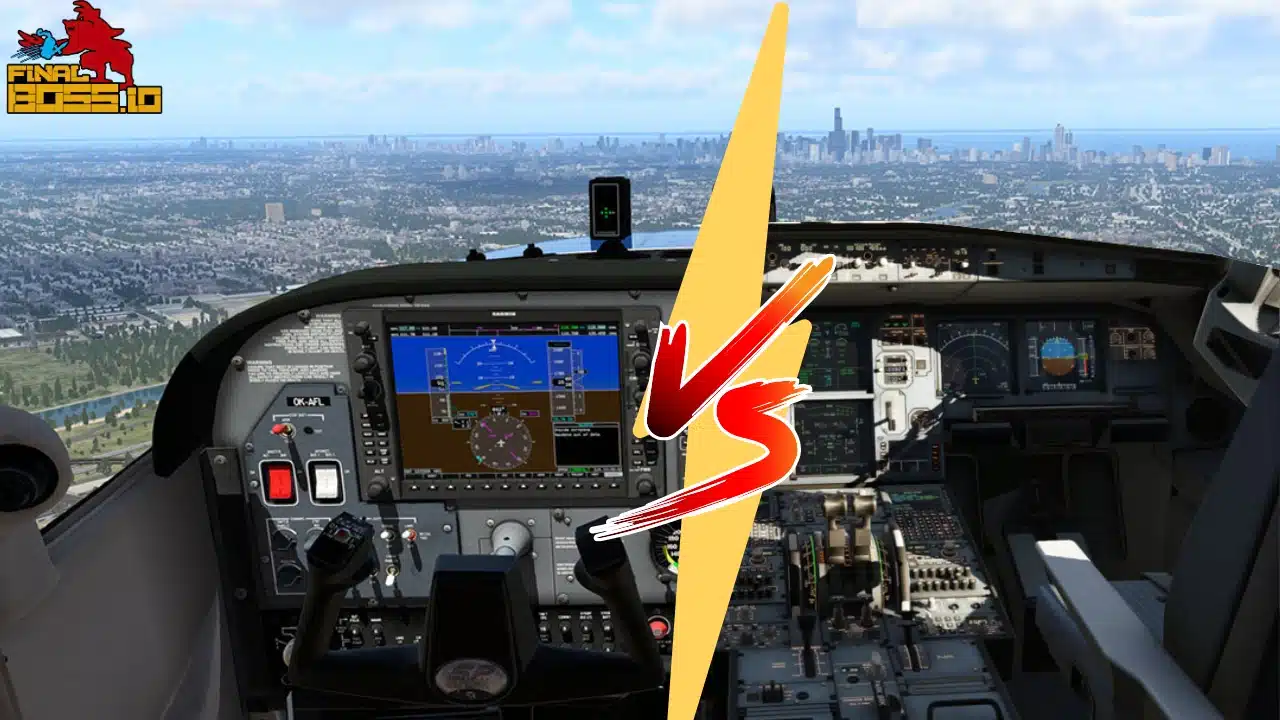
When it comes to experiencing the ultra-realism of flight simulation in X-Plane 12, the choice of control system can make a world of difference. So, we’re here today to clear the runway on the most hotly contested topic in the flight sim community: Yoke vs. HOTAS control systems.
In the world of flight simulation, the Yoke control system is widely considered the more ‘traditional’ control method, mirroring the control setup found in many real-world aircraft. If you’re a stickler for authenticity, you might be already leaning towards a Yoke.
Yoke controls are known for their intuitive design. You push and pull to control the pitch, and turn left and right for the roll. It’s a two-handed affair, just like in a real cockpit, giving you that immersive feel of being a true pilot.
The yoke system shines when used with aircraft that use this type of control in the real world, such as most commercial aircraft like the Boeing 737 or general aviation aircraft like the Cessna 172. This is where the immersive nature of X-Plane 12 truly comes to life.
However, the yoke system isn’t without its drawbacks. It tends to take up a bit more desk space, and for the uninitiated, it might feel a bit unusual to control. Plus, it’s generally not the best choice for aircraft that employ stick controls, like fighter jets or Airbus.
On the other side of the aisle, we have the HOTAS (Hands On Throttle And Stick) system. If you’re all about fast-paced, high-action flying, HOTAS might be the co-pilot for you.
HOTAS controls offer a whole different level of immersion. The joystick offers a more tactile and responsive feel, giving you the sensation of being in direct control of the aircraft. And let’s not forget the throttle quadrant, which allows for some precise power management.
One of the biggest advantages of HOTAS is its versatility. It’s the go-to choice for military aircraft like the F-14 Tomcat, as well as space flight simulators. The HOTAS control system allows for swift and precise manoeuvres, making it perfect for those high-speed dogfights.
But just like the yoke, the HOTAS isn’t perfect. Its learning curve can be a bit steeper, particularly in managing multiple buttons and functions at your fingertips. And, while it can be used for commercial and general aviation aircraft, it may not provide the same level of realism as a yoke would for these types of aircraft.
While we’ve already touched upon the basics of the yoke and HOTAS systems, we haven’t yet discussed another significant factor in your decision: investment. Quality control systems are an investment in your flight sim experience, and the price points can vary.
Yoke control systems tend to be a bit pricier, especially if you’re aiming for top-notch, high-quality models. However, they often come with additional features like integrated rudder controls and multiple buttons for in-flight commands, which can make the investment worthwhile.
HOTAS systems, on the other hand, can be found at various price points. Entry-level models can be quite affordable, but if you’re looking for high-precision control with a plethora of programmable buttons, be prepared to invest a bit more.
It’s important to bear in mind that a high price tag doesn’t necessarily translate to the best fit for you. Instead, consider your budget in alignment with the kind of flight experience you’re looking for in X-Plane 12.
Whether you’re a flight sim veteran or a novice pilot, the learning curve is a crucial aspect to consider when choosing between a yoke and a HOTAS system.
The yoke system, being closely modeled after real-world aircraft controls, can provide a more intuitive feel, especially for those familiar with actual flight controls. However, for newcomers, it may take some time to get used to the controls and understand the various functions at your disposal.
In contrast, the HOTAS system requires a bit more finesse and familiarity with the control setup. With an array of buttons and a joystick to manage, it might feel overwhelming initially. But once you get the hang of it, you’ll appreciate the precision and versatility it offers, especially in more action-oriented scenarios.
Remember, patience is the key. Whichever control system you choose, there will be a learning curve. But isn’t that part of the fun? Mastering the controls and getting better flight by flight is what makes the flight sim experience so rewarding.
So, which control system should you choose for X-Plane 12? It boils down to the kind of virtual pilot you aim to be. If you’re all about that commercial or general aviation life, the yoke might be your best bet. But if you’re looking to engage in some high-octane aerial or even space adventures, HOTAS is your wingman.
Remember, the best control system is the one that enhances your flight simulation experience and makes you feel like the best virtual pilot you can be. Whichever control system you choose, just remember to enjoy the flight. After all, in the words of Laminar Research, X-Plane 12 is not only ultra-realistic, it is THE reality.
Get access to exclusive strategies, hidden tips, and pro-level insights that we don't share publicly.
Ultimate Gaming Strategy Guide + Weekly Pro Tips